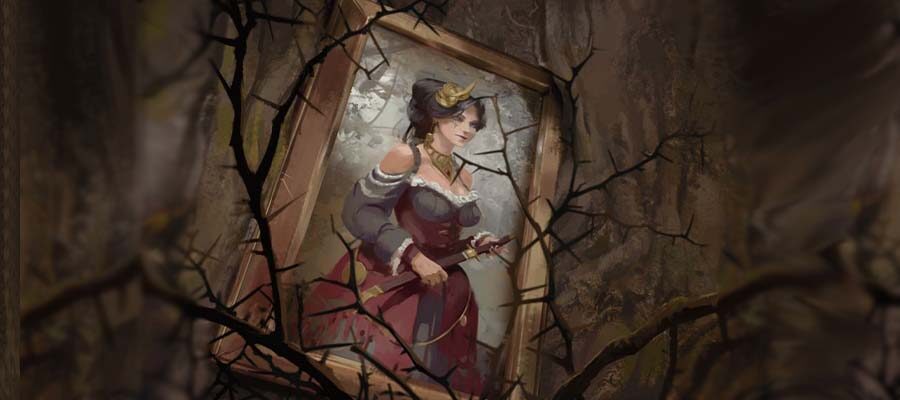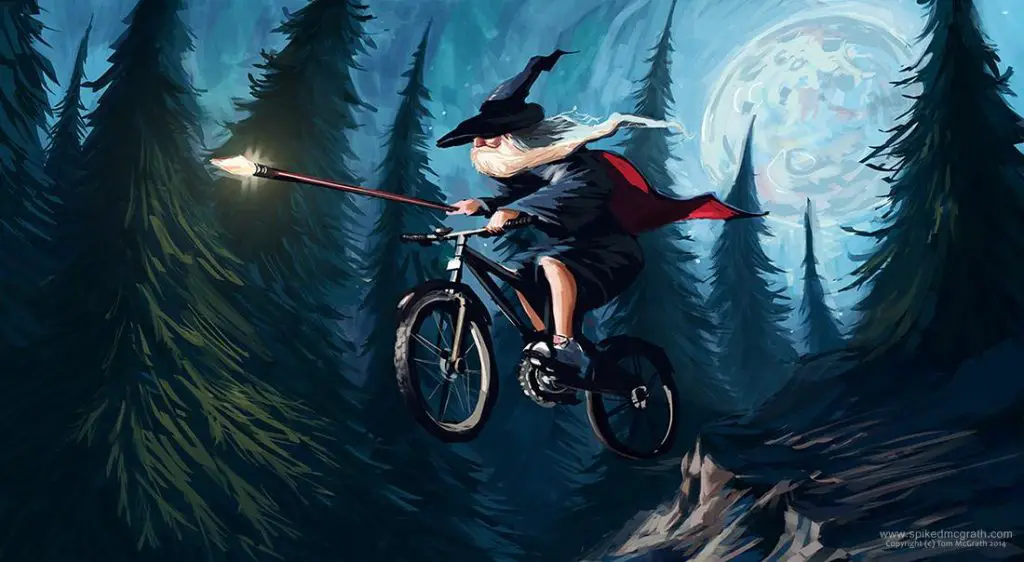Featured D&D 5e character backstory creation prompts image credit to Wizards of the Coast.
Disclaimer: This article contains affiliate links that add gold to our coffers.
With the advent of immersive, character-driven shows like Critical Role, more and more players are looking to create characters with real emotional depth and nuance. But how do you take a Dungeons & Dragon’s character—the “elven ranger,” the “human wizard,” or the “tiefling cleric”—and make them feel as real as Vex’ahlia, Caleb Widogast, or Jester Lavore?
Character backstory definitely plays a role, but as always, quality is more important than quantity. Players who write sprawling, narrative backstories for their characters may often find that ninety percent of what they’ve created rarely comes up at the table. Instead, this article will offer ten basic character-building prompts that, together, create meaning through the things your character does, rather than the things they once were.
Backstory Prompt #1: What was your character’s most recent occupation? What brought them there? What is their “dream occupation,” if any?
Rather than focusing your character around their class, focus on what your character does. Not all clerics of Pelor consider themselves “clerics”; your cleric may be an evangelist, an acolyte, a preacher, a scholar, a soldier, or even an agrarian (for does the Sun not help crops grow?).
Few characters remain adventurers forever, either. Does yours hope to retire into a particular community? Purchase a tavern with the royalties they’ve made? Such dreams or goals can give your character valuable reasons to push them forward into adventure.
Backstory Prompt #2: What’s one interest or hobby that your character has? Where and why did they pick it up?
Whether it’s rock-collecting, bird-watching, or crocheting, a unique interest or hobby can lend a shade of realness to your character, helping them come to life. What does your character do when they’re off-duty, whether they’re travelling the road, resting at an inn, or keeping watch around the campfire?
By tying these interests into your characters’ history, you can create the space for poignant moments and stronger relationships with important NPCs. A fighter who learned the sword from her mentor is a classic—but flat—trope. A fighter who learned to play chess, cards, or painting from her mentor, though, suddenly has a much more vivid and human relationship.
Backstory Prompt #3: Name one secret that your character conceals from others. Why do they keep it a secret? How much would they have to trust someone to reveal it, and under what conditions?
One of the cornerstones of Dungeons & Dragons is the joy of discovery—those moments when a player uncovers something new and exciting about the world. These moments allow players to become invested in the world and story around them—and secrets do the same for player characters, lending additional nuance and depth to seemingly innocuous conversations.
Dungeons & Dragons characters, like real people, have three identities they wear: the identity they show to strangers; the identity they share with their friends; and the identity they share only with their most trusted companions (read more about these concepts through the “Face, Ego, Heart” system in Warren Tusk’s 2006 LARP, The Dance & The Dawn). As your party’s bonds grow stronger, the secrets they share will grow more intimate and meaningful, transforming a ragtag band of adventurers into a true family of friends.
Backstory Prompt #4: Name a fear or phobia your character has. Is it rational or irrational? How has it affected their lives, preferences, or the choices they’ve made?
No person is a hero all of the time. There are always places that we avoid: memories that haunt us; creatures that disturb us; conversations that discomfort us. Fears and phobias create opportunities for “Yes, but…” and “No, but…” moments—moments when a character cannot bear to carry on, or moments when they overcome their fear through the aid of their companions.
Backstory Prompt #5: Name two members of your character’s close family—one that they are close to and one that they are not. How does your character feel about these relationships, and what role have they played in your character’s life?
The members of our families often have the greatest impact on our development, including the way we act, the way we think, and the way we see the world. Not only does this prompt create opportunities for the DM to re-introduce these relatives to the plot of the campaign, it also allows you to consider how your character views NPCs and PCs that resemble their beloved (or despised) family members, coloring their relationships accordingly.
Backstory Prompt #6: Name two of your character’s most interesting personality traits that a stranger would remember after encountering them in a crowded tavern.
How can you ensure that your fellow players remember your character after the first time the party meets them? Like any character in media, these stand-out personality traits will help your character leave an impact on the other players’ minds. Are they boisterous? Shy? Serious? Do they fidget with a particular piece of jewelry, use prestidigitation for emphasis when speaking, or talk in a peculiar way? The choice is yours.
Not only can these traits help your character stand out, they can also help you define the core of your character . What emotion does your character tend to inhabit? How do they act in social settings? How does your character feel about these traits—if they’re a bit of a comedian, are they secretly a “sad clown”? Once you know your character’s key outward-facing attributes, you can easily use those traits as scaffolding for the subtler, inward-facing details of their mind and personality.
Backstory Prompt #7: Think about the spells, weapons, and tools that your character wields. Where did they learn to use each of them, and why? What kinds of components or materials do they prefer? If they cast spells, what aesthetic helps them stand out? If they wield weapons, what is their “fighting style”?
Dungeons & Dragons 5th Edition is, at its core, a game about combat. It makes sense, then, to spend a substantial amount of effort pondering what your character looks like when they’re fighting. After all, a character’s spells and weapons are far more than the generic “attacks” of a Pokemon game; their abilities reflect their history, their personality, and their style of self-expression.
How do they cast magic missile—and what forms do the missiles take? What does it look or feel like to rage? Where did they learn to shoot their first longbow—and who gave it to them? Each combat encounter your character will face is part of a broader tapestry, building on the battles and knowledge they have previously encountered. By highlighting the story of each tool in your character’s toolbox, you can make sure your character sheet shines.
Backstory Prompt #8: What’s one lie your character believes about themselves? What’s one lie they believe about the world?
It’s easy for characters to be right about things—about the morality of their enemies, the history of their people, or the nature of humanity. But what about when your character is wrong? Not only do false beliefs create natural opportunities for inter-party clashes, they also set up future revelations, fueling character growth and development.
Does your character believe that they’re stronger than they are? Weaker than they are? Do they wrongly blame themselves for a tragedy they could never have prevented? Do they believe that the world is wholly good, evil, or uncaring? As your character continues to adventure, they will naturally expose themselves to new situations and points of view, offering new answers—and new questions—for your character to explore.
Backstory Prompt #9: What is something your character wants that may not be good for them? What is something your character should understand or do that they cannot or will not do?
Consider Avatar: The Last Airbender: Prince Zuko wants to capture the Avatar and earn his father’s approval—but he needs to find his own path forward and earn self-respect. These kinds of conflicting “wants” and “needs” have been the fuel for countless character arcs throughout fantasy fiction, and can provide a veritable gold mine for complex, nuanced characters in Dungeons & Dragons.
At the end of Critical Role’s Campaign 2, wizard Caleb Widogast realizes that, although he wanted to travel through time to save his parents from death, he needed to protect and remain with the new family he had found. Similarly, perhaps your ranger wants revenge, but needs compassion; perhaps your rogue wants riches, but needs companionship. This isn’t to say that characters shouldn’t be able to pursue long-term goals, but sometimes, the most meaningful character arcs are those where a character realizes that their goals weren’t what they thought—and what they truly needed was right under their nose the entire time.
Backstory Prompt #10: Where, why, and how did your character learn each skill that they are proficient in? List the three most memorable times they have used one or more of their skills (whether they succeeded or failed).
Why does 5e tie skill proficiencies to character backgrounds as well as classes? Because skills, more than nearly anything else on your character sheet, reflect the richness of your character’s origins, decisions, and experiences. Why did your rogue turn to purse-snatching? What joy does your paladin find in history? What brought your cleric to medicine—and who did they fail to save?
When combined with the histories of your character’s weapons, spells, and other tools, these skill-stories can paint a well-shaded portrait of your character’s personality, drives, and experiences—building a strong foundation for the adventures to come.
Conclusion
Building a character can be one of the biggest joys of beginning a new Dungeons & Dragons campaign, and every player has their own approach to doing so. What prompts or elements do you explore when building a new character? How do you bring new characters to life at the table? Leave your thoughts in the comments below!
For more ideas on creating immersive character background stories, check out Opal’s article Developing a Thorough Background.
About the Author: DragnaCarta is a guest writer for FlutesLoot.com and a veteran DM with 12+ years of experience. He is the author of the popular “Curse of Strahd: Reloaded” campaign guide and the Dungeon Master and director for the Curse of Strahd livestream “Twice Bitten.” You can get his personal RPG mentoring plus early access to projects by joining his Patreon.
Cast Message in the comments section below to ask DragnaCarta about this topic. You can find other articles by DragnaCarta on FlutesLoot.com.





Excellent advise!
Added to the Blog Database.
https://jonbupp.wordpress.com/for-players/backgrounds/
Thank you! We have used those prompts in our campaign to flesh out our characters. We spend one session just writing their background and personalities. It has been a great help!
I am so happy to receive this feedback!! I’m ecstatic to hear this has been of use to you. I often think that developing characters together with the party helps everyone align and understand each other better. Thank you for your comment! May your new adventure be blessed with great roleplaying and aligned schedules 🙂